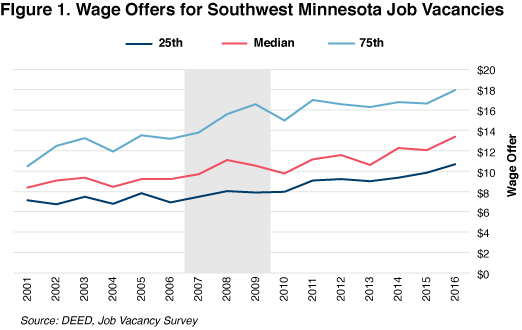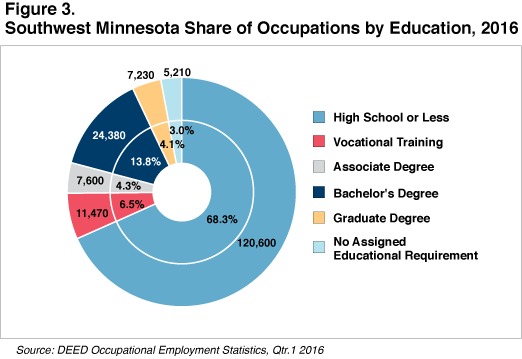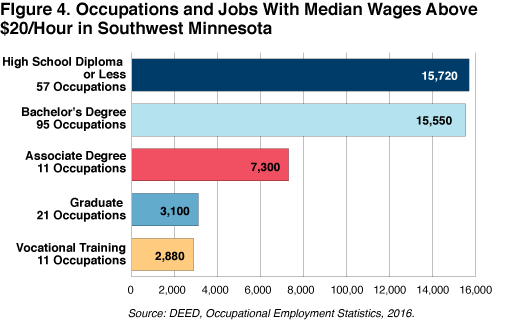
by Luke Greiner
June 2017
With thousands of jobs unfilled, the region might be the canary in the coal mine of what other Minnesota regions could experience in the coming years.
The last three years in Southwest Minnesota have seen a favorable market for job seekers as employers posted record job vacancies. In 2016, employers reported an average of nearly 6,500 job vacancies in the second and fourth quarters. That is well above the 16-year average of 4,583 openings.
Through the first three quarters of 2016, the region averaged more than 176,000 jobs after adding 1,145 jobs over the previous year. The region's annual rate of job creation, however, was just 0.65 percent, compared with 1.4 percent statewide.
A weak economy is probably not the culprit. Instead, stubbornly slow job growth in Southwest Minnesota can be partially blamed on a labor force that has remained stagnant over the last decade, even declining some years.
Given the thousands of unfilled jobs, historically low unemployment rates and employer pleas for more workers, Southwest Minnesota might be a canary in the coal mine of what other regions across the state could experience in the coming years.
Projected job growth for Minnesota from 2014 to 2024 is 4.3 percent, or an average increase of 0.43 percent per year – slower than Southwest Minnesota's growth rate from 2015 to 2016.
Employers might be struggling, but job seekers are finding a favorable environment. In 2016, there were just 1.4 unemployed workers for every job vacancy, down significantly from 7.2 job seekers per vacancy during 2009. Fewer unemployed job seekers competing for a larger number of openings has dramatically changed the job market since the not-so-distant Great Recession.
Strong economic conditions and a historically tight labor market have ignited a race for workers in the region, with starting wage offers on the rise. In the last five years, from 2011 to 2016, median wage offers for job vacancies have risen by $2.26 per hour, growing faster in Southwest Minnesota (up 20.3 percent) than statewide (up 14.8 percent).
The median wage offer for all openings was $13.41 per hour in 2016, although a quarter of openings had wage offers of $17.97 per hour or more, and another quarter had median wage offers of $10.66 per hour or less (see Figure 1).

For a typical family with one child and two adults, each parent would need to earn $14.03 per hour in order to meet basic needs in Southwest Minnesota, according to DEED's Cost of Living tool. Although the median wage offer for job vacancies in the region is just barely under the cost of living wage for a family of three, a single person with no children could meet basic needs with just $12.23 per hour, making Southwest Minnesota the most affordable region in Minnesota.
The growth in starting wage offers appears to be driven more by tight labor market conditions than increasing job requirements, considering the amount of experience required for job openings in the region is actually declining. Almost two-thirds (64 percent) of job vacancies required less than one year of experience, compared with 38 percent of vacancies in 2009. Furthermore, only 5 percent of current vacancies require four or more years of experience, compared with 26 percent in 2009.
The growth in median wage offers probably is not related to increasing educational requirements either. Roughly two-thirds of job openings in Southwest Minnesota require a high school diploma or less, identical to the statewide ratio in 2016. Moreover, less than 1 in 6 job openings require a bachelor's degree or more, while 18 percent require vocational training or an associate degree.
Educational requirements for job vacancies posted by employers in the region have changed little since DEED began tracking them. The trend in educational requirements appears to be a slight decline in the share of jobs requiring a high school diploma or less, while jobs requiring vocational training are near constant. The share requiring a bachelor's degree or more has increased slightly (see Figure 2).

The most visible and pronounced trend in educational requirements is the impact of business cycles. Figure 2 illustrates how educational requirements increased during the recession (shaded in gray), but then relaxed as the economy improved and the number of job seekers declined. For instance, 74 percent of management openings in the fourth quarter of 2016 required postsecondary education, while almost 100 percent had that requirement in 2009.
In 2016, just over 68 percent of jobs in the region (120,600 jobs) required a high school diploma/GED or less. In contrast, only 17.9 percent required a bachelor's degree or more, and 10.8 percent required vocational training or an associate degree. A relatively small number of jobs (3 percent) had no clear educational requirement, falling into catch-all categories with a wide range of skills.
This means that high school students and recent graduates have few educational barriers in the way of employment. Young people ages 14 to 18, however, have been less likely to hold jobs in the region since at least the mid-1990s (Figure 3).

Although many jobs with low educational requirements also have low wages, that isn't always the case. Workers can find good paying jobs at every education level in the region and statewide. The wages for nearly all occupations are driven by economic demand. Wages typically will increase until the incentive attracts enough workers to fill openings. A few of the highest-paying occupations in Southwest Minnesota that require no more than a high school diploma are highlighted in Table 1.
| High Wage Jobs in Southwest Minnesota Requiring a High School Diploma | |||
|---|---|---|---|
| Occupation | Jobs | Half Pay Between | |
| Electrical Power-Line Installers and Repairers | 250 | $28.92 | $39.74 |
| Brickmasons and Blockmasons | 100 | $27.25 | $35.24 |
| Loan Officers | 550 | $22.88 | $43.26 |
| First-Line Supervisors/Managers of Non-Retail Sales Workers | 130 | $25.60 | $37.61 |
| First-Line Supervisors/Managers of Mechanics, Installers and Repairers | 520 | $23.14 | $36.58 |
| Source: DEED Occupational Employment Statistics, 2016 | |||
People often think low educational requirements mean low skills, but these are not synonymous. On the contrary, many workers who earn top wages have advanced their skills through on-the-job training instead of – or in addition to – formal postsecondary education programs. Gaining skills through work experience can boost wage potential and increase job mobility. In effect, learning doesn't stop after completing high school or college.
Even today it's still possible to earn a good income with no more than a high school diploma, but it takes some research to find the right fit and opportunities. Considering the relatively small share of jobs requiring a bachelor's degree and the expense of college, new entrants to the labor force might consider exploring other paths to success.
This does not mean that a college degree doesn't have value. In fact, the highest-paying occupations in Southwest Minnesota require postsecondary education. But again, wage ranges for occupations that require college vary, based on the economic demand for the skills gained through formal education.
Possibly the most important use of these data is to promote and support opportunities that pay well.
Some occupations have a desirable salary but few job openings, thus restricting the opportunity to gain employment. True opportunity exists when there is both high demand and enough employment to have a continual stream of openings.
Nearly 16,000 jobs in 57 different occupations have a median hourly wage of $20 and require a high school diploma or less. This means that there are more jobs in Southwest Minnesota that require a high school diploma with median wages above $20 per hour than those that require a bachelor's degree. There is a greater variety of occupations, however, that pay above $20 per hour that require a bachelor's degree (see Figure 4).

Opportunities for success can be discovered by weighing multiple factors, including personal aptitude and passion, educational requirements, employment and job openings, and earnings potential.
Using these data for guidance, economic and community development organizations should work with all levels of educational institutions, nonprofits and policymakers to help Southwest Minnesota's most precious resource, its people, make smart career choices.